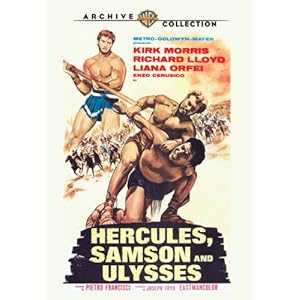
Originally posted on 8/10/12
It's been a long time since I was a kid and my local TV station used to show Italian sword-and-sandal flicks on a weekly show called "Saturday Spectacular." So I'm no expert on the genre but I can tell if an example of it is entertaining or not, and in its own blissfully hokey and cheapjack-"spectacular" way, 1963's HERCULES, SAMSON, AND ULYSSES is just that.
This briskly-paced Warner Archive Collection DVD release comes through with the action sequences we expect without too much lollygagging around in between. It begins with Greek strongman Hercules (Kirk Morris) and his smaller but smarter pal Ulysses (Enzo Cerusico) setting sail from Ithica with their valiant crew to hunt down a sea monster (which, if I'm not mistaken, is actually a live sea cow) that's been killing local fishermen.
A terrible storm sinks their ship, drowns most of their crew, and leaves them stranded in Judea. There, Hercules is mistaken for Samson (Richard Lloyd), a fugitive who battles against the oppression of tyrannical Philestine king Seren (Aldo Giuffrè). Seren threatens to kill Hercules' crew unless he brings the real Samson in dead or alive, but after a massive clash the two titans join forces against Seren, leading to an epic battle against his attacking army.
Admirers of bronzed beefcake will enjoy gawking at the sculpted pecs of matinee-idol handsome Hercules and those of the darker Samson, who resembles a cross between Victor Mature and Frank Stallone by way of the Hulk. When these guys go mano a mano, they make a ruin of the ruins they're fighting in as fake slabs of granite go flying all over the screen. Between tossing each other through stone walls and wrapping iron pipes around their opponents' necks, they even manage to work in a little Greco-Roman wrestling along the way. It's a fight the likes of which I haven't witnessed since the Six Million Dollar Man took on Bigfoot.
Watching Samson devastate Seren's army singlehanded is equally exciting, as he rains down spears upon them with both hands to the accompaniment of some extremely goofy sound effects (and several horse-tripping stunts that should have animal lovers squirming in their seats). Not to be outdone, Hercules whacks both a lion and a bull (at least it looks like a bull to me, though Hercules seems to have no idea what it is) with his bare hands, the latter providing a tasty mystery-meat feast for him and his men.
But this is nothing compared to the spectacular climax in which Hercules, Samson, and Ulysses literally bring the house down while fighting off an advancing horde of Philestine soldiers who, oddly enough, sport German helmets left over from some World War II movie.
Since she's dressed in such a stimulating military-chic dominatrix outfit for this final battle, it may be a good time to mention the gorgeous Liana Orfei as Philestine queen Delilah. Despite the scenic locations and sometimes breathtaking sets (which I assume were left over from a much more expensive film), I found Liana to be the most stunning visual aspect of HERCULES, SAMSON, AND ULYSSES, as Delilah--she of the prediliction for unsolicited haircuts--uses her seductive wiles against our stalwart heroes.
Fortunately, Hercules has an equally hot babe (Diletta D'Andrea) waiting for him at home, and Samson's probably knee-deep in groupies when he isn't chucking spears through bad guys, so they manage to remain immune to the delectable Delilah's lacivious lure.
Morris and Lloyd are adequately photogenic as the heroic hunks, with Enzo Cerusico a curious choice as Ulysses--he's more Bill Bixby than Lou Ferrigno--but this is no doubt meant to emphasize his superior intellect when it comes to figuring out smart stuff like "Push temple over on bad guys!" and "Dive off of burning ship!" The one familiar face I recognized in the cast was that of Aldo Giuffrè ("Seren"), whom fans of THE GOOD, THE BAD, AND THE UGLY will fondly remember as the ill-fated Union officer who fantasized about blowing up that damn bridge.
The "manufactured on demand" DVD from the Warner Archive Collection is in 1.78:1 widescreen with Dolby Digital sound. No subtitles. A cool trailer is the sole extra. I thought the print used looked very good, but be advised--I'm easily pleased.
HERCULES, SAMSON, AND ULYSSES doesn't try to be anything more than a lively, colorful, and unabashedly hokey live-action comic book adventure, and in this it meets expectations quite well. The down-and-dirty rumble between the two big guys alone is worth the price of admission--even Chuck Norris might be hesitant to get involved once those granite blocks start flying.






